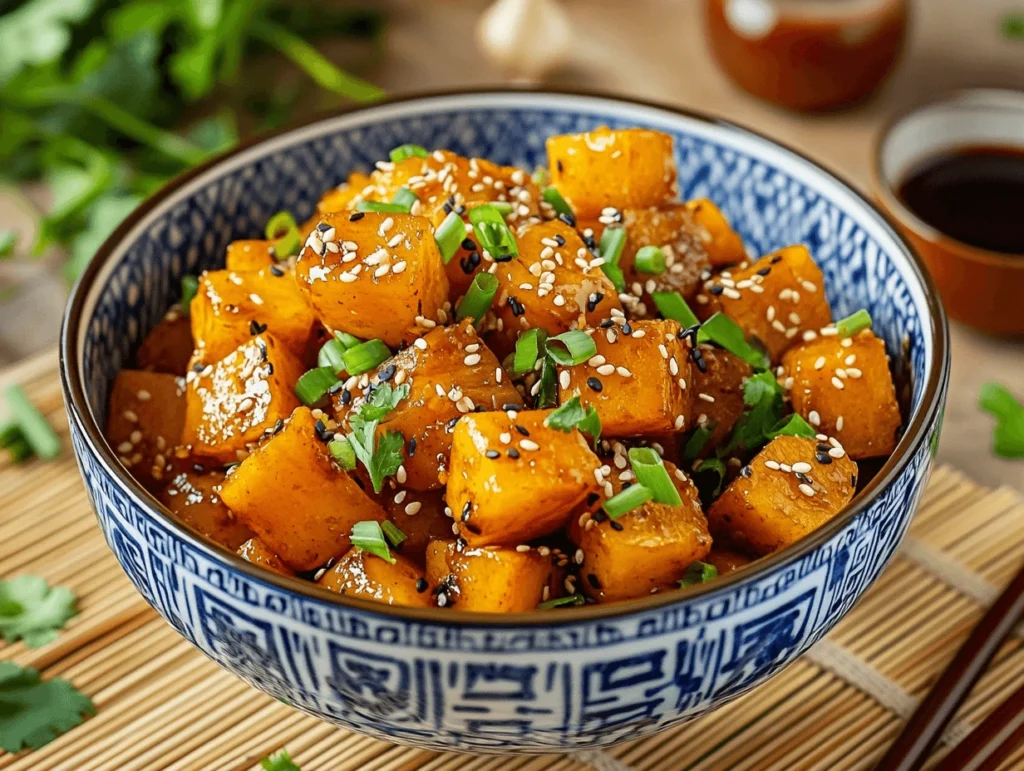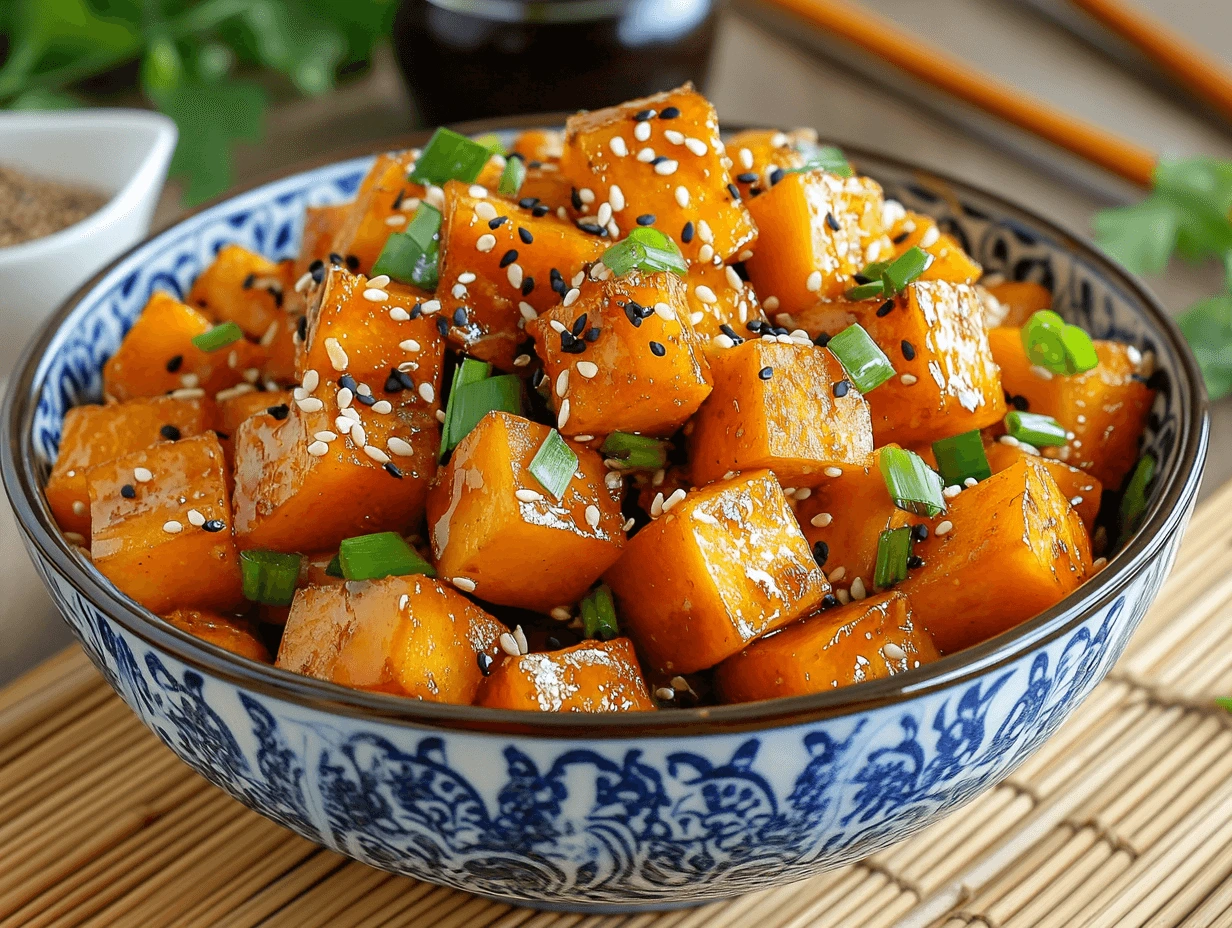Unlock the culinary potential of kabocha squash, a vibrant Japanese pumpkin known for its rich, sweet flavor and versatility. These Chinese squash recipes with kabocha vegan options elevate plant-based cooking to a new level, bringing restaurant-quality flavors straight to your kitchen. Packed with nutrition and bursting with delightful tastes, these dishes are perfect for transforming your vegan meal repertoire.
Table of Contents
Cooking kabocha squash opens up a world of delectable vegan recipes. These recipes are both simple to prepare and packed with incredible taste. Whether you’re a seasoned home chef or a curious food enthusiast, these kabocha squash recipes will inspire you to explore new plant-based culinary adventures.
Key Takeaways
- Kabocha squash provides unique flavor and nutrition for vegan dishes
- Easy to prepare with multiple cooking techniques
- Versatile ingredient for both savory and sweet recipes
- Nutrient-dense alternative to traditional squash varieties
- Perfect for experimental home cooks seeking exciting plant-based meals
Understanding Kabocha Squash: A Guide to Japanese Pumpkin
Kabocha squash, also known as Japanese pumpkin, is loved by chefs and home cooks. It’s a versatile, nutrient-rich vegetable. It adds a sweet flavor to roasted dishes and traditional Asian cuisine.
Nutritional Benefits of Kabocha Squash
Kabocha is a nutritional powerhouse. It offers many health benefits:
- High in vitamin A for eye health
- Rich in antioxidants that support immune function
- Low in calories with excellent fiber content
- Contains essential minerals like iron and magnesium
Selecting and Storing Fresh Kabocha
Choosing the right kabocha for your recipe is key. Look for squash with:
- Deep green color with minimal blemishes
- Heavy weight for its size
- Firm exterior without soft spots
Pro tip: Store your kabocha in a cool, dark place. It can last up to one month when stored right.
Differences Between Kabocha and Other Winter Squashes
Kabocha is unique among winter squashes. Its sweet flavor makes it great for both savory and sweet dishes. It has a denser, smoother texture than butternut or acorn squashes.
“Kabocha is like the secret weapon of squash – compact, sweet, and incredibly versatile!” – Chef Michael Chen
Kabocha is perfect for roasted dishes or traditional Asian recipes. It offers a unique culinary experience that goes beyond other winter squashes.
Essential Tools and Ingredients for Chinese Squash Recipes Kabocha Vegan
To make delicious chinese squash recipes with kabocha, you need the right tools. Start your vegan cooking journey with the right tools and ingredients. They turn this Japanese pumpkin into a culinary masterpiece.
Key Kitchen Tools
- Sharp chef’s knife for precise kabocha squash cutting
- Heavy-bottomed wok for authentic Chinese cooking techniques
- Steamer basket for healthy vegan preparation methods
- Mandoline slicer for uniform vegetable cuts
Cooking kabocha squash needs precision. A good chef’s knife cuts through the squash skin cleanly. A reliable wok ensures even heat for perfect texture.
Essential Ingredients
| Ingredient Category | Recommended Items | Flavor Profile |
|---|---|---|
| Sauces | Tamari, rice vinegar, sesame oil | Rich, umami |
| Spices | Five-spice powder, ginger, garlic | Warm, aromatic |
| Herbs | Green onions, cilantro | Fresh, bright |
Your chinese squash recipes need authentic ingredients. Fresh, high-quality components make your vegan kabocha dishes stand out.
“The secret to incredible squash recipes lies in understanding your ingredients and mastering simple techniques.” – Chef Ming Tsai
Pro tip: Always choose organic, locally sourced kabocha for the healthiest and most flavorful vegan meals. These ingredients take your cooking to the next level.
Basic Preparation Methods for Roasted Kabocha Squash
Cooking kabocha squash needs careful steps and attention. This Japanese pumpkin turns into a tasty dish with the right roasting and seasoning techniques.
Cleaning and Cutting Techniques
Here are the key steps to prepare roasted kabocha squash:
- Wash the squash under cool running water
- Use a sharp knife to cut it in half
- Scoop out the seeds with a large spoon
- Cut the squash into 1-inch cubes for even cooking
Pro tip: Leave the skin on for vegan rice dishes, as it becomes tender and edible when roasted.
Seasoning and Spice Combinations
Enhance your roasted kabocha squash with these seasonings:
- Garlic and rosemary olive oil blend
- Maple and cayenne pepper mix
- Sesame oil with five-spice powder
- Coconut aminos and ginger
Cooking Temperature and Time Guidelines
For perfect roasted kabocha squash, control the temperature:
- Preheat oven to 425°F (218°C)
- Spread cubes on a baking sheet
- Roast for 25-30 minutes
- Turn pieces halfway through cooking
“The key to incredible kabocha is maintaining consistent heat and allowing natural caramelization.” – Vegan Culinary Institute
By following these steps, you’ll make delicious roasted kabocha squash. It will be crispy outside and creamy inside.

Delicious Vegan Kabocha Curry and Soup Variations
Discover the world of vegan kabocha curry and soup recipes. These dishes turn Japanese pumpkin into tasty delights. Kabocha squash adds a creamy texture, making these dishes warm and delicious.
Start your kabocha squash curry journey by learning about its unique flavors. Chinese squash recipes kabocha vegan soup are great for beginners wanting to try new tastes.
- Thai Kabocha Squash Soup: A spicy and aromatic option featuring coconut milk and red curry paste
- Vegan Kabocha Curry: A hearty blend of roasted kabocha, vegetables, and warming spices
- Ginger-Infused Kabocha Soup: A light and comforting recipe with fresh ginger and turmeric
Here are some tips for making your kabocha curry:
- Roast the kabocha squash before adding to your curry for enhanced flavor
- Use coconut milk for a creamy base in your vegan recipes
- Experiment with different spice combinations to create unique taste profiles
“Kabocha squash curry is not just a meal, it’s a culinary journey through Asian-inspired flavors.”
The beauty of thai kabocha squash soup is its simplicity and rich flavor. By choosing fresh ingredients and mastering basic techniques, you can make this squash into a dish that wows everyone.
Creative Sweet and Savory Kabocha Recipes
Kabocha squash is a versatile ingredient in Asian cuisine. It can be turned into delicious dishes in your kitchen. Its unique flavor and texture make it a favorite among chefs and home cooks.
Thai-Inspired Kabocha Dishes
Thai cuisine adds vibrant spices and coconut to kabocha. Try these vegan recipes:
- Kabocha coconut curry with lemongrass
- Roasted kabocha with Thai chili glaze
- Spicy kabocha salad with fresh herbs
Japanese Fusion Preparations
Japanese cooking brings out kabocha’s sweetness in new ways. Here are some tasty options:
- Tempura-style kabocha fritters
- Miso-glazed kabocha steaks
- Kabocha rice pudding with matcha
Chinese-Style Cooking Methods
Chinese cooking turns kabocha into stunning dishes. Here are some amazing recipes:
| Dish | Preparation Style | Key Ingredients |
|---|---|---|
| Stir-Fried Kabocha | Wok Cooking | Ginger, Garlic, Soy Sauce |
| Kabocha Dumplings | Steamed | Scallions, Sesame Oil |
| Braised Kabocha | Slow Cooking | Star Anise, Rice Wine |
Each recipe offers a unique way to enjoy kabocha. Your meals will be both healthy and tasty.
Conclusion
Exploring chinese squash recipes kabocha vegan opens a world of plant-based cooking. You’ve seen how versatile and nutritious this Japanese pumpkin is. It can make simple ingredients into amazing dishes.
You’ve learned techniques and recipes for vegan meals. Kabocha squash is great for both Thai and Chinese dishes. It adds rich flavor and nutrition to your cooking.
Now, you can make ordinary meals special. You know how to prepare and season kabocha squash. It’s time to explore more plant-based recipes.
Cooking is a journey of learning and fun. Your skills will improve with each new recipe. Kabocha squash will become a favorite in your vegan kitchen. Start trying new things and enjoy every bite.
FAQ
What is kabocha squash and how is it different from other pumpkins?
Kabocha squash is a Japanese pumpkin known for its sweet, nutty taste. It has a dark green skin and bright orange inside. Unlike regular pumpkins, it’s smaller and sweeter. Its creamy texture is great for vegan dishes and Asian recipes.
How do I select a ripe and fresh kabocha squash?
Choose a kabocha squash with a deep green color and hard skin. It should feel heavy and have no soft spots. A sweet smell and a firm stem are signs of freshness.
What are the best ways to prepare kabocha squash for cooking?
First, wash the squash well. Cut it in half with a sharp knife and remove the seeds. You can roast it whole or cut it into cubes or wedges. The skin is edible and gets tender when cooked.
Is kabocha squash nutritionally beneficial?
Yes, it’s very nutritious! It’s full of vitamins A and C, beta-carotene, iron, and fiber. It’s low in calories and carbs, making it good for health and vegan diets. It supports immune function and overall wellness.
Can I use kabocha squash in different types of cuisines?
Yes, it’s very versatile. It’s great in Chinese, Japanese, Thai, and other Asian dishes. You can use it in curries, soups, stir-fries, and even desserts. Its flavor adapts well to many recipes.
What are some vegan cooking methods for kabocha squash?
You can roast, steam, bake, sauté, or puree it. Roasting enhances its sweetness, while steaming keeps nutrients. Use it in curries, soups, rice bowls, or as a side dish.
How long can I store kabocha squash?
Whole squash can last up to a month in a cool, dry place. Cut pieces should be stored in an airtight container in the fridge for 3-5 days. Always check for spoilage before cooking.
Are there any common allergens in kabocha squash recipes?
Kabocha squash itself is usually safe. But, be careful of nuts, soy, or spices in vegan recipes. Always check the ingredients and talk to people about their allergies.
Did you tried this Recipe ?
There are no reviews yet. Be the first one to write one.

